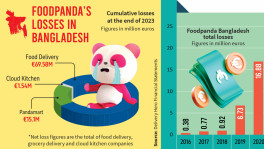Motorcycle crash: Time to rein in the chariots of death
While many countries including the biggest producers of motorcycles are attempting to discourage the use of motorcycles, Bangladesh seems to be moving in the opposite direction. Motorcycle producers are targeting Bangladesh as a highly potential market due to its growing popularity among the people

As motorcycles increase in popularity among people of different socioeconomic backgrounds in Bangladesh, road accidents involving this vehicle are also on the rise. As a convenient alternative to inadequate and uncomfortable public transports, motorcycles attract young commuters in particular.
With the upward social mobility, along with the men, a growing number of working women are nowadays considering motorcycles as a 'gender sensitive' and time-efficient transport. It also helps avoid the rampant sexual harassment on public transportations.
Despite all of its usefulness and comfort, the two-wheeler has already proven fatal on the roads in Bangladesh.
The highest ever road accidents took place on the latest Eid journeys across the country, due to a host of reasons.
According to a TBS report, at least 681 people were killed and 2,077 injured in road accidents in 12 days before and after Eid with the motorbike accidents ranking top in death toll.
During the period, on an average, 56 people died and 264 injured daily in road accidents, the report said, quoting a study conducted by Save The Road. Prepared based on news reports, the study shows at least 190 people were killed and 968 wounded in motorcycle accidents.
Another study conducted by Jatri Kalyan Samity revealed that motorcycles were involved in 44.08 percent of the crashes and 34.85 percent of the deaths in 15 days from April 26.
Even in 2021, a non-governmental organisation reported that 6,284 people died and 7,468 were injured in 5,371 traffic collisions. Of them, 2214 people died from motorcycle crashes, which alone contributed to 35.23 percent of the total fatalities in traffic accidents around the country.
Motorcycles have been identified as an accident-prone vehicle in many developed countries, along with countries that are top exporters of the vehicle. The three biggest exporters of motorcycles are China, Germany, and Japan. Collectively, these major motorcycle exporters generated most of the total value for international motorcycle sales in 2020: China: $8.6 billion (28.3% of total exported motorcycles); Germany: $2.87 billion (9.4%); and Japan: $2.1 billion (6.9%).
China, currently the top exporter, identified a motorcycle as an accident-prone vehicle and started banning the two-wheel commuter in the early 1990s. In the beginning, the ban was implemented in Beijing, the capital city of the country. Soon after that, other cities also started following Beijing, and a total of 185 cities in the country gradually imposed restrictions on motorcycles.
Germany, the second-highest motorcycle exporter, has several separate laws and ordinances to impose restrictions on motorcycles. On some roads in Germany, there is a speed limit imposed only on motorcycles. In addition to that, riding motorcycles is strictly prohibited in some areas considering the safety concerns. While garnering infamy as a safety risk, motorcycles are also accused of being noisy.
Japan stands third among motorcycle exporters. Japanese motorcycles are the most popular motorcycles in Bangladesh. Japan revised its road rage law in 2020 and the amendment of the country's Road Traffic Act imposed more significant penalties for acts of aggressive driving and road rage.
There are specific restrictions and rules on riding a motorcycle on highways, in public places, and other particular areas. It is reported that the implementation of such laws and regulations significantly contributed to reducing motorcycle accidents in Japan.
These common steps are found in traffic policies of different countries, which include strong implementation of a traffic law; separate speed limit for motorcycles; ban on motorcycles in particular areas and highways; emphasis on safety gears, etc.
It should also be noted that banning or controlling motorcycles is also associated with issues other than safety concerns, e.g. availability of alternative options like public transport, quality of roads, proper implementation of law and people's obedience of it, people's choice and priority, etc.
However, while many countries including the biggest producers of motorcycles are attempting to discourage the use of motorcycles, Bangladesh seems to be moving in the opposite direction. Motorcycle producers are also targeting Bangladesh as a highly potential market due to its growing popularity among the people, particularly among the young generation of the country.
The increased mobility of people, lack of a proper public transportation infrastructure, growing urbanisation, comparatively low purchase and maintenance costs for motorcycles, poor licensing procedures, inadequate training for riders, use of illegal ways to get licence and registration, etc. are the main causes of the popularity of motorcycles.
Although traffic law has recently been revised in Bangladesh, the slow process of digitisation and the prevalence of corruption are hindering the proper enforcement of the law.
Apart from the lack of implementation of traffic laws and policy issues, there is the pervasive disregard of using safety gears among motorcycle riders in Bangladesh. Although motorcycles are becoming affordable for different sections of the population, particularly for the young middle-class generation, the cost of safety gear is going up and remains expensive for many bikers.
In the current market, the cost of a full set of gears ranges from a minimum of BDT 20,000 to BDT 80,000. The basic gears a rider needs are a pair of gloves, an all-weather jacket, and a good, preferably DOT or ECE certified helmet.
Along with the high price of safety gears and the policy issues, there are social issues like the propensity for machismo among young riders that compound the lack of use of safety gears. A collective denial to follow rules, along with a dearth of proper orientation regarding motorcycles is transforming a convenient vehicle into a chariot of death.
Despite the numerous social and economic potential of motorcycles, the risk needs to be weighed to reduce casualties in motorcycle crashes. Steps need to be taken from multiple actors including government, producers (companies), and users, such as:
1) Bangladesh Road Transport Authority (BRTA) should update the registration and driving licence procedures considering the contemporary traffic contexts, modernise the driving test system, specify helmet quality (currently helmets are mandatory in traffic law but it lacks quality certification).
2) A separate speed limit can be applied for motorcycles on highways and expressways.
3) A short message about traffic law/penalties can be sent to the registered mobile number of motorcycle users once a week.
4) Along with a helmet, the minimum number of other safety gears like all-weather protective jacket, protective hand gloves, knee and elbow guard, etc. should be mandatory for motorcycle riding, particularly in highways and expressways.
5) "No helmet, no fuel" policy should be mandatory for all filling stations across the country because in rural areas, the use of helmets is lesser than in urban areas.
6) Increase and improve the use of public transports as alternative means of transportation to discourage motorcycles.
7) Motorcycles with advanced safety technology should be encouraged.
8) Bangladesh has already allowed bikes with 165cc, it should not lift the speed limit or increase it, although the users and producers are demanding for an increase in CC ranges.

Aminur Rahman is a researcher at the Social and Gender Division of Bangladesh Institute of Social Research (BISR) Trust.
Disclaimer: The views and opinions expressed in this article are those of the author and do not necessarily reflect the opinions and views of The Business Standard.


 Keep updated, follow The Business Standard's Google news channel
Keep updated, follow The Business Standard's Google news channel
















